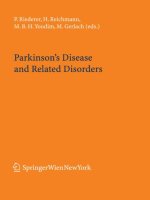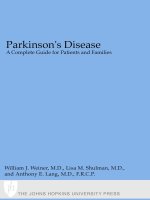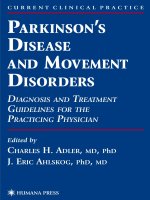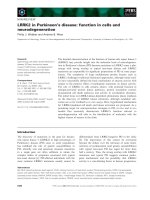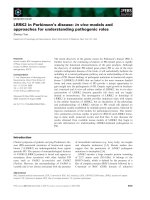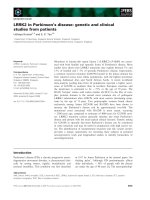Psychiatric and Cognitive Disorders in Parkinson’s Disease pptx
Bạn đang xem bản rút gọn của tài liệu. Xem và tải ngay bản đầy đủ của tài liệu tại đây (1.02 MB, 241 trang )
MMMM
This page intentionally left blank
Psychiatric and Cognitive Disorders in Parkinson’s Disease
Emotional and cognitive disorders are common in Parkinson’s disease, but are frequently
overlooked or undertreated. This book provides a comprehensive account of these aspects of
Parkinson’s disease, based on the neurologic and psychiatric assessment of hundreds of
patients by the authors. It also oVers a thorough survey of the published literature on the
topic.
Readers will Wnd a complete and helpful overview of the clinical features and treatment of
Parkinson’s disease, followed by discussion of associated depressive disorders, anxiety,
phobias, apathy, hallucinations, delusions and sleep disorders. SpeciWc cognitive deWcits are
also discussed, and the mechanisms for these disorders explored. In addition, the book
addresses the psychiatric and cognitive side-eVects of antiparkinsonian medications and new
surgical treatments.
OVering suYcient scientiWc detail for the specialist in neurology and psychiatry, the clear
practical guidelines, case studies and rating scales will meet the needs of all clinicians working
with Parkinson’s disease patients.
Sergio E. Starkstein was Assistant Professor of Psychiatry at Johns Hopkins University, and
is now head of the Dementia Clinic at the La Sagrada Familia Clinic, and Director of the
Buenos Aires Neuropsychiatric Center.
Marcelo Merello was a Research Fellow at the National Hospital for Neurology and
Neurosurgery in London, and is now head of the Movement Disorders Section (FLENI) in
Buenos Aires.
MMMM
Psychiatric
and Cognitive Disorders
in Parkinson’s Disease
Sergio E. Starkstein
La Sagrada Familia Clinic and Buenos Aires Neuropsychiatric Center
Buenos Aires, Argentina
Marcelo Merello
Raul Carrea Institute of Neurological Research-FLENI
´
Buenos Aires, Argentina
The Pitt Building, Trumpington Street, Cambridge, United Kingdom
The Edinburgh Building, Cambridge CB2 2RU, UK
40 West 20th Street, New York, NY 10011-4211, USA
477 Williamstown Road, Port Melbourne, VIC 3207, Australia
Ruiz de Alarcón 13, 28014 Madrid, Spain
Dock House, The Waterfront, Cape Town 8001, South Africa
© Cambridge University Press 2004
First published in printed format 2002
ISBN 0-511-04069-5 eBook (netLibrary)
ISBN 0-521-66305-9 hardback
For our beloved wives, Corina and Alicia
MMMM
Contents
Preface
ix
1
Introduction
1
2
Epidemiologic, clinical, and therapeutic aspects of
Parkinson’s disease
4
3
Parkinsonism and Parkinson’s disease
34
4
Cognitive deficits in Parkinson’s disease
55
5
Depression in Parkinson’s disease
88
6
Anxiety, phobias, apathy, and premorbid personality in
Parkinson’s disease
114
Neuropsychologic and psychiatric side-effects of
antiparkinsonian medication
129
Treatment of psychiatric disorders in Parkinson’s disease
142
Appendix
References
Index
161
179
225
7
8
vii
MMMM
Preface
As part of our clinical and research activities in neurology and psychiatry,
we had the chance to examine hundreds of patients with Parkinson’s disease
(PD). The Movement Disorders Unit kept us abreast of the new developments in the management of the clinical complications of PD, and made us
aware of the emotional, behavioral, and cognitive complications of the
disease. These problems have been speciWcally studied at the Departments
of Neuropsychiatry of our Institutes, where we carry out most of our clinical
and research activities in the interface between neurology and psychiatry.
Whereas emotional problems such as depression and anxiety are very
prevalent in PD, they are rarely diagnosed and treated. One of the reasons
for the low awareness of mood problems in PD is that some of the key
symptoms of depression, such as psychomotor retardation, lack of energy,
loss of libido, insomnia, and low energy, are also frequently found among
PD patients. There may also be a tendency to ‘‘expect’’ PD patients to be
somewhat depressed based on their physical limitations, and to consider
depressed mood as an ‘‘understandable’’ consequence of the illness. On the
other hand, behavioral problems such as delusions and hallucinations
dramatically aVect both patients’ and caregivers’ lives, and treatment is
readily obtained. Cognitive disorders slowly develop in a high proportion of
PD patients, and the familial and Wnancial impact of this complication is
comparable to that in other dementias.
Thus, it is frequently the case that a PD patient with moderate or severe
disease is burdened by a variety of clinical problems, such as a progressive
depressive mood, worries about their motor problems, loss of selfconWdence, and avoidance of social situations where their motor diYculties
may become manifest. Tremor and akinesia tend to increase dramatically in
social situations, leading to episodes of ‘‘freezing.’’ Patients are usually well
ix
x
Preface
aware of these potential complications, and tend to avoid social contact by
staying at home. With the progression of the illness, many PD patients
develop cognitive deWcits that may sometimes evolve to full-blown dementia. At this stage, delusions and hallucinations are frequently present, and
their severity is signiWcantly related to the dose of antiparkinsonian medication (i.e., the higher the dose, the greater the risk of psychotic behaviors).
The dilemma then arises as to how to improve the patient’s motor status
while at the same time avoiding the risk of psychotic behaviors.
The past two decades witnessed an increasing number of investigations
about the emotional, behavioral, and cognitive disorders in PD. To produce
this book we had to go over hundreds of papers, sometimes with contradictory Wndings, with the need to address the complexities of the disease for the
specialist, while at the same time allowing the text to remain accessible to
the generalist. We hope that this goal was adequately met and that the book
proves useful to a variety of mental-health-related professionals, such as
neurologists, psychiatrists, geriatricians, general practitioners, psychologists, and social workers.
Finally, we would like to acknowledge our great mentors, Bob Robinson
and Andy Lees, for all their encouragement and support during many years,
as well as a number of excellent collaborators who helped with our research
activities during the past 10 years. They are Gustavo Petracca, Eran
Chemerinski, Janus Kremer, Lilia Canevaro, and Angel Cammarota. We
also thank Jonathan Robinson for proof reading the book before its Wnal
edition. Last but not least, this book would never have reached its Wnal stage
without the great secretarial skills of our dear Laura Miguez.
Sergio E. Starkstein
Marcelo Merello
1
Introduction
Parkinson’s disease (PD) is a frequent neurologic disorder among elderly
individuals. Whereas the hallmark of the disease is the presence of abnormal
movements, comorbid psychiatric and cognitive abnormalities are frequently found. The major aim for the present book was to include up-todate information regarding the diagnosis, phenomenology, and treatment
of the psychiatric and cognitive disorders of PD in one single volume.
Most patients with PD are usually cared for by internists and general
practitioners, but the information about emotional and cognitive comorbid
conditions is usually found in specialized neurologic and psychiatric journals. Our book is aimed at senior clinicians and trainees in internal
medicine and general practice, at neurologists who may want a better
understanding of their patients’ ‘‘non-motor’’ problems, and at geriatric
psychiatrists who may want to access the relevant information about emotion and cognition in PD, and update their knowledge about the motor
complications and treatment of this disorder.
The second chapter provides a strong clinical background of the motor
problems of PD before discussing the psychiatric and cognitive disorders
related to the illness. We address the epidemiology and main clinical aspects
of PD, and a clinical case is presented to illustrate the progression along the
stages of the illness. There is also speciWc discussion of the diVerent clinical
complications that may emerge during the evolution of the disease and the
subtypes of the illness. Treatment strategies for the motor disorder are
speciWcally addressed, with discussion of emotional and cognitive beneWts
and complications of the diVerent pharmacologic approaches such as the
use of neuroprotective agents, levodopa (l-dopa) and dopaminergic agonists, anticholinergics, and other compounds. This chapter also includes a
review of the most recent surgical treatments for PD, such as the stereotaxic
1
2
Introduction
lesion or stimulation of the posteroventral-pallidum, the thalamus, and the
subthalamic nucleus, with special emphasis on the potential cognitive and
emotional implications of these techniques.
In the third chapter we revise the most important diVerential diagnoses
of PD to help the clinician understand diagnostic dilemmas of the disease.
We provide clinical vignettes and discuss clinical aspects and laboratory and
neuropathologic Wndings of multisystem atrophy, progressive supranuclear
palsy, and corticobasal degeneration. Special attention is given to the
spectrum of Lewy body disease, and clues for the diVerential diagnosis
between PD and other neurodegenerative conditions, drug-induced
parkinsonism, and parkinsonism related to depression, stroke, and ‘‘cortical’’ dementias are also provided.
In the fourth chapter we discuss the most frequent cognitive deWcits in
PD such as deWcits in executive functions, visuospatial abilities, speech,
language, attention, and memory. We examine their prevalence, potential
mechanisms, and neuroimaging correlates. There is also an in-depth discussion of dementia in PD. After presenting a clinical vignette, we discuss
methodologic issues related to the diagnosis of dementia in PD, and review
the prevalence and phenomenology of dementia in this disorder. We
speciWcally review cognitive, emotional, motor, and neuroimaging diVerences between so-called ‘‘subcortical’’ dementias (e.g., PD) and ‘‘cortical’’
dementias (e.g., Alzheimer’s disease (AD)), and revise the clinical correlates
and mechanism of dementia in PD. SpeciWc reference is made to neuropathologic aspects of dementia in PD, such as coexisting AD pathology,
cortical Lewy bodies, and depletion of neurotransmitter systems.
In the Wfth chapter we examine the prevalence and phenomenology of
depression in PD. We discuss the main strategies used to diagnose an
aVective disorder among patients with a neurologic disorder that may
‘‘mimic’’ a depressive condition, and we revise the main psychiatric instruments and diagnostic criteria used to carry out the patient’s evaluation. We
then discuss the impact of depression upon cognitive functioning, activities
of daily living, quality of life, and evolution of the motor disorder. Finally,
we examine biological markers and neuroimaging correlates of depression
in PD and discuss potential underlying mechanisms for this condition.
In the sixth chapter we address behavioral disorders frequently reported
in PD such as anxiety, panic attacks, phobias, and apathy. We discuss clues
3
Introduction
for the diagnosis of these problems and present illustrative cases. PD
patients were reported as having ‘‘high moral standards,’’ ‘‘moral exactitude,’’ ‘‘great social conformism,’’ and ‘‘inXexible social interactions.’’
However, it was only recently that speciWc personality traits in PD have been
investigated with standardized instruments. This chapter presents the main
evidence for and against a speciWc personality ‘‘type’’ in PD.
In the seventh chapter we review the main cognitive and psychiatric sideeVects of antiparkinsonian medication. We discuss the dilemma of improving the motor status of a patient while at the same time increasing the risk of
behavioral problems, and examine alternatives for managing these diYcult
situations. The main psychiatric side-eVects of antiparkinsonian medications are hallucinations, delusions, illusions, delirium, and sleep disorders.
We examine their prevalence, main clinical correlates, and potential
mechanisms. We then address the cognitive and emotional side-eVects of
speciWc antiparkinsonian drugs, such as l-dopa, dopaminergic agonists,
amantadine, selegiline, and anticholinergic drugs.
In the eighth, and last, chapter we discuss the main somatic and psychological treatments of the psychiatric disorders of PD. The eYcacy and
side-eVects of diVerent types of antidepressants (e.g., tricyclics, monoamine-oxidase inhibitors, selective serotonergic reuptake inhibitors) and
antipsychotic agents (e.g., clozapine, risperidone, olanzapine, quetiapine)
are speciWcally revised, and the usefulness of other treatment modalities,
from relevant social and familial interventions to electroconvulsive therapy,
is discussed.
Finally, the Appendix comprises seven scales that are frequently used to
rate the physical and behavioral disorders of PD, as well as deWcits in
activities of daily living, and quality of life.
2
Epidemiologic, clinical, and therapeutic
aspects of Parkinson’s disease
Involuntary tremulous motion, with lessened muscular power, in parts not in action
and even when supported, with a propensity to bend the trunk forwards, and to pass
from a walking to a running pace: the senses and intellects being uninjured.
James Parkinson, 1817
Introduction
Since its initial description in 1817, PD remains an unsolved clinical
problem, with a changing focus during the past four decades. Thus, the
1960s were the years of dopamine discovery; the 1970s witnessed a leap
forward in the treatment of the disease by the introduction of replacement
therapy with l-dopa; the 1980s witnessed motor complications emerging
from chronic long-term l-dopa treatment; and the 1990s were primarily
devoted to genetic and neuroimaging studies, the search for putative biological markers, and the rebirth of surgical treatment for the disease.
This chapter will examine relevant epidemiologic, clinical, and therapeutic aspects of PD and will provide the neurologic basis for the in-depth
discussion of neuropsychiatric and cognitive aspects of the disease that
follows.
Clinical vignette
A.B. is a 54-year-old accountant who noticed mild tremor in his right hand while reading
the newspaper. A diagnosis of PD was made and the patient was started on l-dopa, which
was followed by the disappearance of tremor. One year later, he noticed tremor during
stressful situations, and his signature became smaller. He also noticed dragging of his
right foot when walking. This overall picture illustrates the period of stable response to
l-dopa.
Two years later, the patient developed clumsiness in both legs and abnormal gait. There
was resting tremor in both hands, mostly in stressful situations. He had an abnormal
4
5
Phenomenology of PD
flexed posture and lacked bilateral arm swing. The patient became less communicative in
social situations and had a marked reduction in voice volume. The motor response to
l-dopa was stable during the day, but he would wake up in the morning with bilateral
tremor, difficulty in walking, and slowness while washing and shaving, followed by
marked improvement 10–20 minutes after taking the first dose of l-dopa. This illustrates
the period of stable response with early morning akinesia.
Two years later, despite an increase in l-dopa dosage and combination therapy with
bromocriptine, the patient showed difficulties with most daily activities, as well as recurrence of tremor and other parkinsonian signs about 3–4 hours after taking l-dopa. His
balance was normal but he was unsteady when turning around, and the frequency of
l-dopa intake had to be increased. This illustrates the period of fluctuating response with
wearing-off phenomena.
One year later, the patient became severely disabled in his daily activities. Nights were
very uncomfortable due to increased rigidity. During the day he experienced a rapid
decrease in medication efficacy: more than 30 minutes were necessary to ‘‘switch On’’
(i.e., to experience motor improvement), and ‘‘Off’’ periods (i.e., lack of motor improvement) lasted for more than 2 hours (e.g., he was totally disabled after lunch). Bromocriptine doses were progressively increased, but without a consistent motor improvement.
He developed involuntary movements during the period of best medication effect, which
were noticed by his wife but not by the patient himself. This illustrates the period of
fluctuating response with wearing-off phenomena, delayed On, poor response with
empty stomach, and peak dose chorea.
Two years later the patient was on a schedule of 800 mg l-dopa and 3 mg pergolide
every 3 hours, but continued to experience wearing-off about 2–3 hours after medication
intake. He was well aware of severe right-side involuntary movements, both at the
beginning and at the end of each l-dopa dose. He also reported that the effect of
medication would suddenly disappear during stressful situations, to return about 5–10
minutes later. Occasionally, the medication failed to switch him On, which mostly ocurred
after meals. The patient developed severe postural instability during Off periods. He was
unable to work, and needed assistance with most regular chores. This illustrates the
period of fluctuating response with wearing-off phenomena, the On–Off phenomenon,
delayed On, poor response with empty stomach, failure of dose, and biphasic dyskinesias.
Phenomenology of PD
Staging of illness
PD is a chronic and progressive disorder, which is usually divided into Wve
diVerent stages of severity (Table 2.1) (Hoehn & Yahr, 1967). As illustrated
6
Epidemiologic, clinical, and therapeutic aspects
Table 2.1. Modified Hoehn and Yahr staging of PD
Stage 0
No signs of disease
Stage 1
Unilateral disease
Stage 1.5 Unilateral disease plus axial involvement
Stage 2
Bilateral disease, without impaired balance
Stage 2.5 Bilateral disease, with recovery on pull test
Stage 3
Mild to moderate bilateral disease; some postural instability; physically independent
Stage 4
Severe disability; still able to walk or stand unassisted
Stage 5
Wheelchair-bound or bedridden unless aided
Adapted from Lang et al. (1995).
in the clinical vignette, stage I (i.e., stable response to l-dopa) is characterized by symptoms exclusively or more prominently on one side of the body
(Hughes et al., 1993). Parkinsonian signs such as tremor, rigidity, and
bradykinesia may be conWned to one side of the body for months or years,
with a mean duration for this stage of about 3 years. Activities of daily living
(ADLs) are usually not aVected in this stage. Stage 2 (i.e., stable response
with early morning akinesia) is characterized by spreading of parkinsonian
signs to the opposite side of the body and to axial structures. During this
stage the side initially aVected still remains relatively more aVected, but
there is Xexed posture with adduction of limbs, facial masking with monotonous speech, mild disturbance of gait, generalized slowness, and a decreased amplitude of associated movements. These signs are mostly mild,
and balance is usually not aVected. Stage 3 (i.e., Xuctuating response with
wearing-oV phenomena) is characterized by impairment of balance and
abnormal postural reXexes. Patients walk unsteadily and have diYculties
when turning around. When pushed, patients may take several steps backwards to maintain upright posture, and may fall. During this stage patients
are functionally independent in household chores, but may show some
limitations at work. Stage 4 (i.e., Xuctuating response and On–OV phenomena) is characterized by increasing disabilities and partial dependence for
most ADLs such as eating, dressing, and washing. All cardinal symptoms of
the disease are markedly worse. During stage 5, the last of the illness,
patients are completely dependent in their ADLs and restricted to a wheelchair or bed bound. They require constant nursing care, and the main cause
of death is aspirative pneumonia (Morgante et al., 2000).
7
Phenomenology of PD
Before the introduction of l-dopa, the mean survival period after the
onset of parkinsonian signs was 10 years, and the rate of observed mortality
was three times that of the general population (Hoehn & Yahr, 1967).
Following l-dopa introduction, life expectancy increased by a mean of 6
years (Yahr, 1976).
Clinical features
The cardinal signs of PD are resting tremor, rigidity, bradykinesia, and loss
of postural reXexes. We will now address each of these signs separately.
Resting tremor
A 3–5 Hz hand tremor (‘‘pill rolling’’ tremor) is usually the initial symptom
of the disease, and becomes most evident when hands are at rest.
Parkinsonian tremor usually dampens during action or with support, but
some PD patients may also show action tremor. Lower lip or chin tremor is
not uncommon, but leg tremor is less frequent. Patients may show increased resting tremor when performing activities with the contralateral
hand, during eVortful thinking, and while walking.
Rigidity
Parkinsonian rigidity is characterized by a constant resistance to passive
movement (‘‘lead pipe’’ rigidity). Patients usually describe a stiV feeling,
and rigidity may be elicited during physical examination. A ratchety catching known as ‘‘cogwheeling’’ may be felt when wrists are passively rotated,
or while moving the arms at the elbow and the legs at the knee. Cogwheeling
results from a combination of rigidity and tremor, and is not speciWc to
parkinsonism (Kurlan et al., 2000).
Bradykinesia
This term is used to refer to slowness of movement or impaired initiation of
movement, whereas hypokinesia or akinesia refer to poor movement or lack
of movement. This symptom is usually the most disabling to patients.
Postural instability
PD patients have problems in standing up from a sitting position, maintaining postural stability, and adopting an erect posture. Patients may lose
8
Epidemiologic, clinical, and therapeutic aspects
balance spontaneously or prove unable to maintain balance when pulled
backwards. About one-third of PD patients have frequent falls.
PD patients may also show a diversity of additional motor symptoms,
which are mostly variants of the cardinal signs described above. Hypomimia, or loss of facial expression, also termed ‘‘masked face,’’ is most likely
to be the result of combined bradykinesia and rigidity, and dysarthria,
hypophonia, and sialorrhea may have a similar mechanism. Other manifestations of bradykinesia are micrographia, decreased blink rate, loss of arm
swing, and shuZing gait. Respiratory problems are frequent and mostly
result from respiratory muscle restriction due to rigidity. Other frequent
Wndings are blepharospasm (i.e., involuntary bilateral eye closure produced
by spasmodic contraction of the orbicularis oculi muscles), the ‘‘striatal’’
hand (i.e., a hand deformity often confused with rheumatoid arthritis), foot
deformity, and scoliosis (Hartman & Abbs, 1988; Jankovic, 1987; Kurland et
al., 1987; Logemann, 1988; Sudarsky & Ronthal, 1983; Weiner et al., 1984).
A variety of oculomotor abnormalities have been described in PD patients,
such as visual contrast deWcits, upgaze limitation, abnormalities in smooth
pursuit and vestibulo-ocular reXexes, decreased blink rate, positive glabellar
reXex, eyelid aperture apraxia, and hypometric saccades (White et al.,
1981).
The following non-motor clinical signs may also be frequently present in
PD.
Autonomic dysfunction
This disorder may result from the disease itself or from antiparkinsonian
drugs, and includes constipation, excessive saliva production, excessive
perspiration, bowel dysfunction, impotence, loss of libido, and hyposmia.
Orthostasis
Orthostatic hypotension is a reduction in systolic blood pressure of at least
20 mmHg or a reduction in diastolic blood pressure of at least 10 mmHg,
within 3 minutes of standing. Symptomatic or asymptomatic orthostatic
hypotension may be present in up to 15% of normal elderly subjects, but the
presence of severe orthostatic hypotension and other autonomic signs
suggests alternative diagnoses to PD, such as multiple system atrophy
(Hughes et al., 1993).
9
Phenomenology of PD
Dementia
Cognitive impairment commonly develops in a large proportion of
parkinsonian patients. This subject is further discussed in chapter 4.
Depression
Depressive mood is present in about 40% of cross-sectional samples of PD
patients, and most PD patients may show depression at some point in their
longitudinal evolution. This issue is further discussed in chapter 5.
Psychotic features
Hallucinations, delusions, and illusions occur in about 40% of
parkinsonian patients on dopamine replacement therapy, but are uncommon as a manifestation of the disease itself. This subject is further discussed
in chapter 7.
Clusters of parkinsonian signs and subgroups of the disease
A question now arising is whether PD constitutes one single and clinically
homogeneous disorder, or whether it should be considered as a generic
term that covers a variety of somewhat related clinical subgroups. Based on
the clinical heterogeneity of PD, several authors proposed subgroups with
speciWc clinical characteristics (Zetusky et al., 1985). The identiWcation of
subgroups may be useful provided that this classiWcation predicts genetic
risk, associated clinical complications, rate of progression, or response to
treatment. Zetusky et al. (1985) used the term ‘‘classical-PD’’ to refer to
those patients with tremor as the predominant parkinsonian sign. This type
of PD has a relatively early onset, relatively mild bradykinesia and postural
instability, a relatively low prevalence of dementia, and a relatively higher
likelihood of a positive family history of either PD or postural tremor. The
second type of PD was termed ‘‘akinetic–rigid’’, and is characterized by a
relatively high prevalence of dementia, depression, postural instability, and
gait disorders.
Several authors (Barbeau & Roy, 1982; Quinn et al., 1987; Yokochi &
Narabayashi, 1981) separated an ‘‘early’’ from a ‘‘late’’ onset form of PD.
The current consensus is to use the term ‘‘early-onset’’ PD whenever
parkinsonian signs develop before 40 years of age. This group is further
subdivided into a ‘‘juvenile’’ type, whenever parkinsonian signs develop
10
Epidemiologic, clinical, and therapeutic aspects
Table 2.2. Most prevalent motor fluctuations in PD
Short-lasting motor Xuctuations
Paradoxic kinesis
Freezing gait
On–OV
Medium-lasting motor Xuctuations
Beginning of dose motor deterioration
End of dose motor deterioration
Wearing-oV
On–OV
Yo-yoing
Diurnal Xuctuation
Sleep beneWt
Long-lasting motor Xuctuations
Menstrual Xuctuations
Adapted from Quinn (1999).
before 21 years of age, and an ‘‘adult’’ type, whenever parkinsonian signs
develop between 21 and 39 years of age. Juvenile-type PD was reported to
have a strong genetic component (Pineda-Trujillo et al., 2001), whereas
early-onset, adult-type PD usually shows dystonia as the initial symptom,
and dyskinesias and motor Xuctuations relatively early after the onset of
illness. Finally, the term ‘‘late-onset’’ PD is used whenever parkinsonian
signs develop after 40 years of age, and is the most frequent type of PD.
Motor fluctuations
Motor Xuctuations are considered to be an inevitable result of long-term
l-dopa therapy, and may produce severe disability. Motor Xuctuations may
disrupt daily activities, and may occur together with Xuctuations in mood
and in sensory and autonomic functions (Table 2.2). About half of the
patients with PD develop motor Xuctuations and dyskinesias at some point
during the illness (Sweet & McDowell, 1975). Several factors, such as l-dopa
dose and age at onset of motor signs, may inXuence the rate of motor
complications in PD. After a 6-year treatment period, patients on a low-
11
Phenomenology of PD
dose l-dopa regimen (:500 mg/day) were reported to show a prevalence of
motor Xuctuations of 52% and a prevalence of dyskinesias of 54%, whereas
patients on high doses of l-dopa (91000 mg/day) were reported to show a
higher prevalence of motor Xuctuations and dyskinesias (80% and 88%,
respectively) (Poewe et al., 1986). Kostic et al. (1991) reported that 96% of
their series of patients with onset of PD before 40 years of age developed
motor Xuctuations, compared with 64% of PD patients with onset of
parkinsonism after 40 years of age, supporting a signiWcant association
between early-onset PD and a greater risk of developing motor Xuctuations.
Motor fluctuations related to l-dopa
L-dopa may produce three diVerent motor responses: (1) A short-term
response, which consists of a motor improvement that roughly parallels the
increasing plasma l-dopa level and ends in a peak motor response; (2) a
long-term response, which consists of a slowly increasing motor improvement that deteriorates over several days; and (3) an inhibitory response
(‘‘super OV’’), which consists of a motor deterioration following or preceding the short-term response, and which may last from a few minutes to up
to one hour (Nutt et al., 1988, 1997a, 1997b; Merello & Lees, 1992). All three
motor responses are superimposed on a diurnal pattern of motor function,
which is independent of l-dopa therapy and which is characterized by
improved morning performance due to sleep beneWt and declining evening
function (Currie et al., 1997; Merello et al., 1997).
Types of motor fluctuations
Stable motor response
A stable response is deWned as an l-dopa-related improvement of motor
function in the absence of motor Xuctuations in patients on less than Wve
daily doses of l-dopa. This response is typically observed during the early
course of the disease and may last for several years. A stable response occurs
whenever a short-term response to a single l-dopa dose provides sustained
motor beneWt and overlaps with both the previous and following doses.
Wearing-off
Wearing-oV is the return of parkinsonian signs at the end of the l-dopa dose
cycle, and results from the progressive decline of the short-term response.
12
Epidemiologic, clinical, and therapeutic aspects
Early morning akinesia is the earliest sign of wearing-oV and is produced by
overnight l-dopa withdrawal. Beginning and end of dose ‘‘rebounds’’ are
negative responses (i.e., more severe parkinsonian signs) that may occur at
the beginning or end of each l-dopa cycle (Nutt et al., 1988; Merello & Lees,
1992).
On–off phenomenon
The so-called ‘‘On–OV’’ motor Xuctuation is a rapid switching from On to
OV states, which mostly occurs in advanced cases of PD (Nutt et al., 1984,
1992). ‘‘Yo-Yoing’’ consists of a chaotic Xuctuation between On and OV
states, which usually occurs in patients receiving complex l-dopa dosing
schedules.
Dyskinesias
Dyskinesias are involuntary choreic, ballistic, or dystonic movements elicited by l-dopa or dopamine agonists. Dyskinesias occurring during the On
state are termed ‘‘peak-of-dose.’’ These abnormal movements are usually
triggered by motor activity or stress, and may decrease with motor relaxation and inactivity. Some patients may experience dyskinesias both at the
beginning and end of an l-dopa dose cycle, which is known as ‘‘biphasic
dyskinesia.’’
Prevalence and etiology of PD
Parkinson’s disease is a common disorder with a prevalence of 85–187 cases
per 100 000 individuals (Brewis et al., 1966; Jenkins, 1966; Tanner et al.,
1987) and an annual incidence of 12.4 cases per 100 000 women and 16.2
cases per 100 000 men (Tanner et al., 1987). Incidence rates for PD were
found to increase with age in both sexes (Bower et al., 2000).
The etiology of PD remains unknown, but several mechanisms have been
proposed. PD was considered to be a manifestation of accelerated aging
(McGeer et al., 1977; Koller et al., 1986), but most available evidence
suggests that PD is not simply an exacerbation of the normal aging process
and is not explained by age-related brain changes (Gibb & Lees, 1987).
Consistent evidence suggests that PD may result from free radical toxicity
produced by oxidative reactions (Foley & Riederer, 2000). Free radicals
13
Neuroimaging correlates of PD
generated by the oxidative metabolism of dopamine have an immediate
reaction with membrane lipids, causing lipid peroxidation, membrane
injury, and cell death. The compound, 1-methyl-4-phenyl-1,2,3,6-tetrahydropyridine (MPTP), is a self-injected drug used by addicts which may cause
a clinical syndrome almost indistinguishable from PD, and is the best
example of an environmental cause of parkinsonism (Langston & Ballard,
1984). The role of oxidation in the mechanism of PD was further
strengthened by the Wnding of high levels of iron in the substantia nigra of
PD patients (Becker & Berg, 2001). This mineral is known to facilitate
oxidation and to decrease levels of glutathione, a chemical that protects
against free radical formation. Several population studies demonstrated a
higher prevalence of PD in industrialized countries compared with agricultural communities (Masalha et al., 1997). Other studies reported a signiWcant association between PD and long-term consumption of well water, or
between PD and working with industrial pesticides (Semchuk et al., 1992;
Gorell et al., 1999; Racette et al., 2001).
Less than a century after James Parkinson’s original description, Gowers
(1896) suggested a familial aggregation for PD in some of his patients, but
the role of genetics in PD remained a controversial issue for decades. During
the last 10 years, several authors reported pedigrees of PD patients with a
dominant pattern of inheritance (Kurland, 1958; Hoehn & Yahr, 1967;
Duvoisin, 1984). A recent multivariate analysis demonstrated a family
history of PD to be the main independent risk factor for the disease
(Werneck & Alvarenga, 1999), and several uncontrolled studies reported
frequencies of PD in Wrst-degree relatives of probands with PD ranging
between 2% and 47% (Barbeau & Roy, 1982). However, the genetic pattern
of PD is not homogeneous, and may include age-related non-penetrance
and complex segregation of traits from multiple loci (Polymeropoulos,
2000). A recent study reported a signiWcantly increased risk of PD in carriers
of the APOE-2 allele, and the presence of at least one E2 allele was found to
multiply the risk for developing dementia in patients with PD (Harhangi et
al., 2000).
Neuroimaging correlates of PD
Metabolic activity in the basal ganglia, and dopaminergic neurotransmission, have been extensively examined in PD using positron emission


